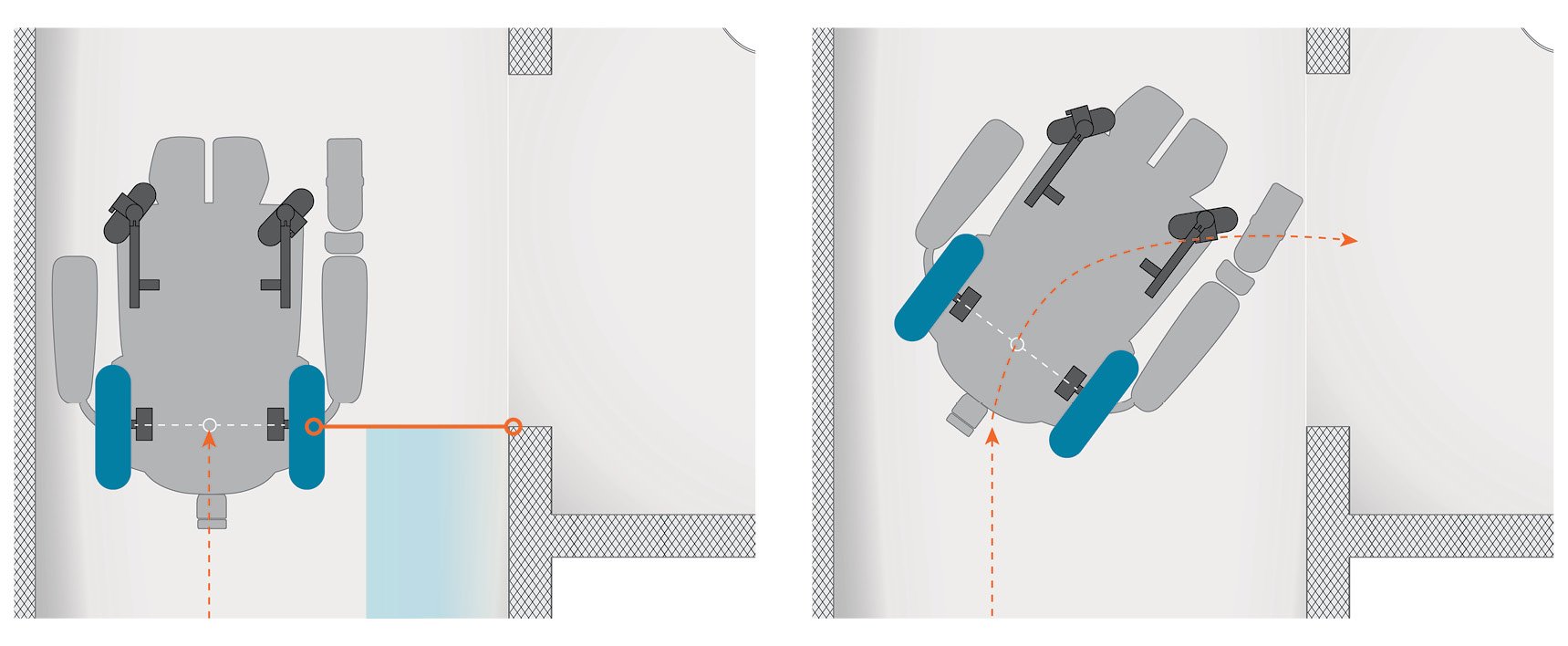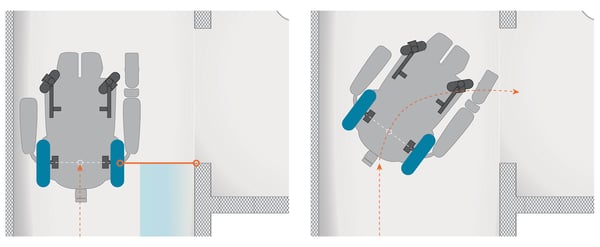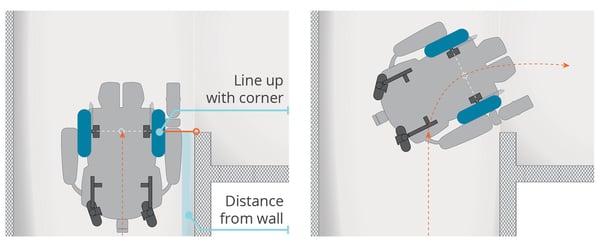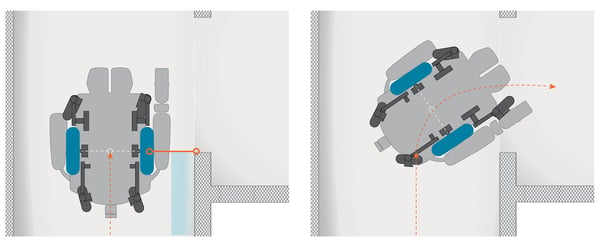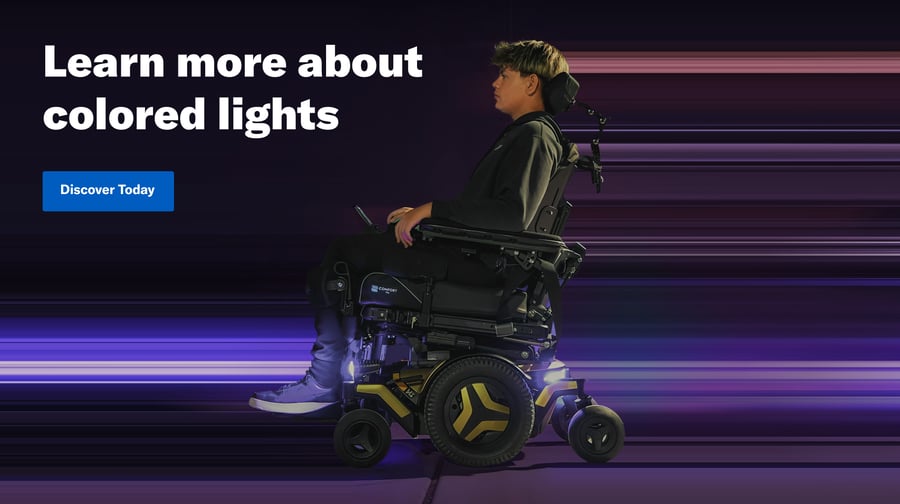There are three primary types of drive wheel configuration for power wheelchair bases: front-wheel drive (FWD), mid-wheel drive (MWD), and rear-wheel drive (RWD). In our previous blog posts, we have explored the advantages and considerations of each configuration. Today, we will delve into techniques that can optimize driving with these drive wheel configurations.
With any drive wheel configuration, it is best to practice driving techniques in all settings where the chair will be used to develop optimal driving strategies.
RWD drives most like a car (wider turns, front end moves):
- Keep feet in as close as possible while avoiding front caster interference to minimize footprint for maneuverability.
- When performing a 90-degree turn to the right from a hallway, the chair should be positioned on the left side of the hallway to allow the front wheels to turn into the doorway successfully. -
- Line up front casters straight on for optimal obstacle climbing.
- Adjustment of the seating system can improve weight distribution/stability when navigating inclines and rough terrain.
FWD drives most like a forklift (back end moves):
- When positioned adjacent to a wall/barrier, turn toward the wall/barrier, then reverse slightly to allow rear caster clearance for turning in the desired direction (away from the wall/barrier).
- When performing a 90-degree turn to the right from a hallway, the chair should be positioned on the right side of the hallway to allow the rear wheels to avoid hitting the wall. This is sometimes referred to as hugging the corner.
- When pulling into a vehicle/bus or to line up with a sink against the wall, it is helpful to pull all the way forward before initiating the turn.
- Obstacle climbing is possible from any direction due to the absence of small front casters.
- Navigate declines slowly without abrupt stopping to avoid forward instability; tilting chair posteriorly (if equipped with power tilt) helps distribute weight for improved stability.
MWD turns on its own center (tight turning, quick turns):
- Keep feet in as close as possible while avoiding front caster interference to minimize footprint for maneuverability.
- When performing a 90-degree turn to the right from a hallway, the chair should be positioned in the center of the hallway to allow the chair to turn into the doorway successfully.
- Line up front casters straight on for optimal obstacle climbing.
- When negotiating transitions , the client may need to approach at an angle instead of straight on to avoid high centering.
In a study through the Human Engineering Research Laboratories, Veterans Affairs Pittsburgh Health Care System, Departments of Bio-Engineering, Rehabilitation Science and Technology, University of Pittsburgh, Pittsburgh, PA; and Department of Design and Environmental Analysis, Cornell University, Ithaca, NY, various power bases were compared with the following results reported.
Mid-wheel drive PWCs [power wheelchairs] required the least space for the 360-degree turn in place compared with front-wheel drive and rear-wheel drive PWCs (P < 0.01) but performed equally as well as front-wheel drive models on all other turning tasks.
Even though the front-wheel drive models were longer and likely had larger swing angles in the rear compared with mid-wheel drive and rear-wheel drive configurations, users maneuvered these chairs in the least amount of space around the L-turn.
Our PWC findings combined suggest that front-wheel drive and mid-wheel drive wheelchairs are better than rear-wheel drive wheelchairs for maneuvering in confined spaces. Maneuverability of front-wheel drive PWCs may be more intuitive and easier to learn for users who are new to powered mobility or have impaired proprioception because turns can be initiated closer to the bend.
The handling of front-wheel drive PWCs may be more intuitive for some users because the center of rotation is toward the front of the wheelchair, enabling the user to initiate a turn at the bend versus having to judge when to begin initiating a turn in order to accommodate a wider front-end swing angle. (Koontz, Brindle, Kankipati, Feathers, & Cooper, 2010) However, the person may have difficulty maneuvering and turning the chair when close to obstacles.
Regardless of the power wheelchair drive wheel configuration, the size of the drive wheels and casters also has an important bearing on how the wheelchair base performs. The larger the wheel, the larger the obstacle it can negotiate. The client should prioritize their individual needs related to where and how they intend to use the chair (indoor vs. outdoor). This will inform which type of drive wheel configuration and caster/drive wheel size is best. Again, it is important to reiterate that each individual chair model will offer various degrees of the characteristics listed above. This information is generalized, and when prescribing an actual power wheelchair, one must consider the features of the specific model being recommended and allow the client to test the specific chair(s) in everyday settings.
 Amy Morgan, PT, ATP
Amy Morgan, PT, ATP
Director Product Management ‑ Power Wheelchairs
Amy has been involved in complex rehabilitation technology since beginning her career as a physical therapist in 2000. Amy’s clinical experience primarily includes outpatient and inpatient pediatric care at Cincinnati Children’s Hospital where she worked with a variety of patient populations. Additionally, Amy was the lead therapist in the Wheelchair/Seating Clinic and Comprehensive Neuromuscular Care Center. In 2007, she joined Permobil as the Pediatric and Standing Clinical Specialist/National Clinical Education Manager where she presented lectures both nationally and internationally and provided input to design for new products. Amy has also worked in Sales at Permobil as the Territory Sales Manager for central/southern Ohio where she earned top sales awards multiple years. She is now part of the Marketing organization as the Director of Product Management for Permobil’s power mobility product line.
 Faith Saftler Savage, PT, ATP
Faith Saftler Savage, PT, ATPSeating Specialist and Consultant
The Boston Home
Faith has over 40 years of experience as a physical therapist, seating specialist and rehabilitation technology supplier, treating persons of all ages with a variety of disabilities. She has been working as a seating consultant at The Boston Home for 30 years assisting residents with MS and other chronic disabilities in obtaining appropriate manual and power wheelchair systems to improve posture, comfort, function and independence in mobility. She runs an outpatient clinic at The Boston Home and assists people in the community with diagnoses including SCI, MD, CP and MS to obtain appropriate equipment.
She has published chapters in journals and books including; International Journal of MS Care, Fundamentals in Assistive Technology and Physical Rehabilitation. Speaking topics include seating assessment, power mobility and alternative positioning. Faith received her BS in Physical Therapy from Ithaca College in New York.
